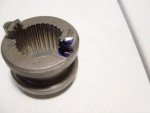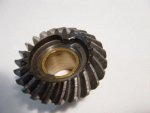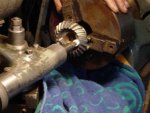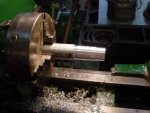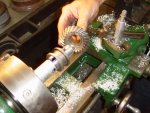As outlined is some previous posts, we had problems with our 1960 75 HP Starflite. Wouldn?t stay in gear, forward or reverse. A teardown showed a damaged clutch dog, as well as damaged clutch mating faces on both gears. (See photo). The clutch, at under $100 was doable, but at nearly $1000 for the gears -- no way.
Talked with a machinist friend, an old timer who works on Corvairs of the same vintage. He said the gear faces needed to be precision ground (not machined). So I turned to my son-in-law, who is teaching himself machining and has all the tools. He first created a test shaft, which would allow the gear/clutch to be tested for mating. (Photo).
He then set up a tool post grinder on a lathe. (photo) He selected a grinding wheel that matched the radius of the clutch dog purchase on the gear. After truing the stone, the gear was chucked in the lathe, and the surface was gently ground. It was absolutely necessary the keep the opposing purchase surfaces at 180 degrees. Using Prussian Blue, we tested, using the new clutch dog. The first gear was right on, the second needed a slight touch-up.
I can report that the engine (a college graduation present, along with a 1969 Glaspar boat, for my son) shifts great, and after several hours of testing (chasing the elusive Yellow Tail) stays in gear just fine.
I must note: this is NOT a job for a hand-held Dremel grinder. But based on the time spent, it should be quite affordable to have a machine shop do the job.
Talked with a machinist friend, an old timer who works on Corvairs of the same vintage. He said the gear faces needed to be precision ground (not machined). So I turned to my son-in-law, who is teaching himself machining and has all the tools. He first created a test shaft, which would allow the gear/clutch to be tested for mating. (Photo).
He then set up a tool post grinder on a lathe. (photo) He selected a grinding wheel that matched the radius of the clutch dog purchase on the gear. After truing the stone, the gear was chucked in the lathe, and the surface was gently ground. It was absolutely necessary the keep the opposing purchase surfaces at 180 degrees. Using Prussian Blue, we tested, using the new clutch dog. The first gear was right on, the second needed a slight touch-up.
I can report that the engine (a college graduation present, along with a 1969 Glaspar boat, for my son) shifts great, and after several hours of testing (chasing the elusive Yellow Tail) stays in gear just fine.
I must note: this is NOT a job for a hand-held Dremel grinder. But based on the time spent, it should be quite affordable to have a machine shop do the job.




















